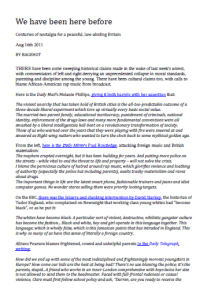Following the police shooting of Mark Duggan in Tottenham, widespread rioting broke out during August 2011 in London and many other English cities. If you don’t remember or aren’t familiar with the civil unrest, the BBC has a handy timeline of events.
I recently came across an Economist arti cle, written at the time and addressing the various political responses to the unrest, called “We have been here before: Centuries of nostalgia for a peaceful, law-abiding Britain” (to read the article you’ll need to register for free access. To save you the time and trouble, I’ve put together a pdf version that you can download) that I think teachers and students will find both interesting and useful for Crime and Deviance for a couple of reasons:
cle, written at the time and addressing the various political responses to the unrest, called “We have been here before: Centuries of nostalgia for a peaceful, law-abiding Britain” (to read the article you’ll need to register for free access. To save you the time and trouble, I’ve put together a pdf version that you can download) that I think teachers and students will find both interesting and useful for Crime and Deviance for a couple of reasons:
1. It documents a range of mainly New Right explanations for – and solutions to – the unrest / rioting that you might find useful as a way of illustrating “popular New Right” ideas about crime: an ever-revolving selection of The Usual Suspects – from teachers, through parents to the detrimental influence of whatever is the Popular Music Du Jour (in this particular instance, Rap takes the…err…biscuit).
2. It draws extensively on Geoffrey Pearson’s very wonderful “Hooligan: A History of Respectable Fears” (1983) to show how, over the past 150 -200 years, the same kinds of “popular responses” to all kinds of civil unrest, disorder and downright deviance appear and reappear at regular intervals.
Finally, the article draws on Pearson’s work to provide an interesting comparative overview of a range of popular (and perhaps moral if you’re that way inclined) panics that students should find interesting, illuminative and instructive:
• fears, in the 1840’s, of a rise in working mothers and the detrimental effect this had on the morals of the young (a regular and long-running favourite in the Popular Press – or Mainstream Media if you’re that way inclined – ever since),
• the “spread of child labour” (a problem not, as you might be forgiven for thinking, that Child Labour is something entirely disgusting and reprehensible but rather because “it put money in the pockets of impressionable youths”, apparently).
• contemporary panics around “Rock’n’Roll in the 1950’s or sexual deviancy in the guise of “Peace’n’Love” in the 1960’s.
Related Posts You Miight Like:
Discover more from ShortCutstv
Subscribe to get the latest posts sent to your email.

